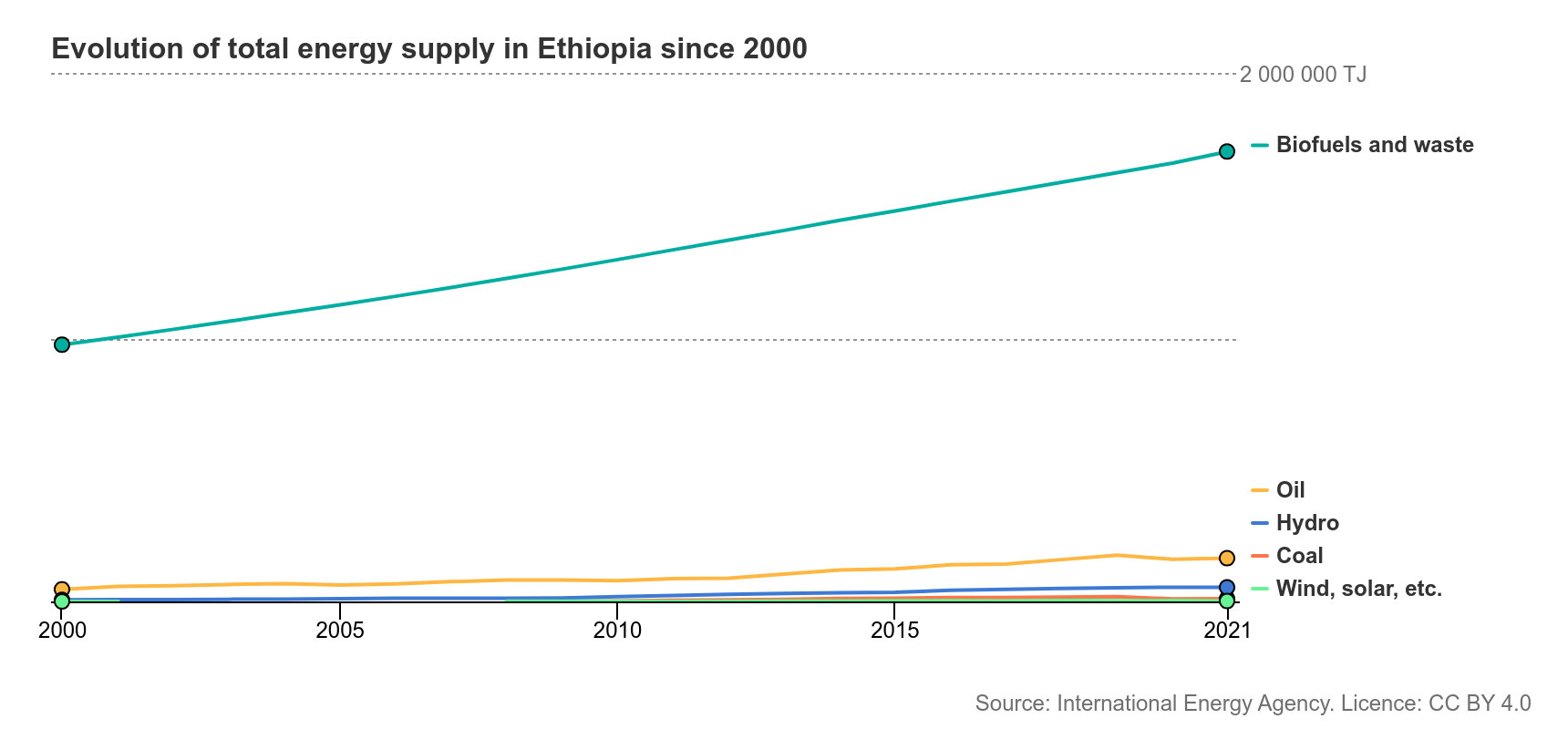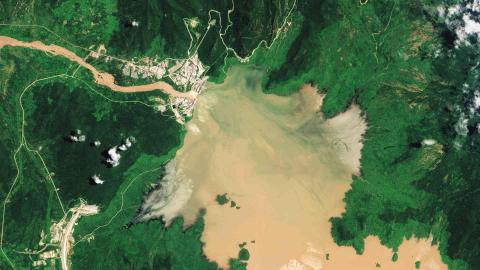Summary by Geopolist | Istanbul Center for Geopolitics
The study titled ““Energising Africa”: Italy vis-a-vis Ethiopia’s Renewable Energy Development” provides insights into the renewable energy projects in Ethiopia and how Italy’s Mattei Plan for Africa could potentially enhance these efforts.
Key points:
- Current Projects:
- The document mentions several ongoing renewable energy projects in Ethiopia, such as a $600 million project capable of generating 300 MW of energy, the Aluto Langano geothermal energy plant producing about 7.3 MW of power, and the Aysha wind farm project, expected to create 2,000 jobs during construction and operational phases.
- Potential for Italy-Ethiopia Cooperation:
- Italy’s Mattei Plan for Africa could serve as a catalyst for Ethiopia’s renewable energy development. Italy could support Ethiopia through fostering partnerships, investing in infrastructure and diplomacy, and leveraging its influence in international forums such as the G7 to mobilize EU member states’ support for Africa’s renewable energy path.
- Private-sector-led infrastructure development, including cross-border regional power infrastructures, could position Ethiopia as a regional hub for renewable energy, creating jobs and economic opportunities, and contributing to regional peace and stability.
- Challenges and Financial Needs:
- Ethiopia’s renewable energy potential is significant, but the sector suffers from low private investment. With over 60% of the population lacking access to electricity, Ethiopia faces challenges in integrating climate resilience into its national development strategies due to underinvestment and high debt.
- The country estimates needing approximately $316 billion to achieve its climate goals by 2030, highlighting the need for substantial climate finance from diverse sources.
- Strategic Importance:
- Italy’s engagement in Ethiopia’s renewable energy sector could provide Italian investors access to a rapidly growing market in East Africa, positioning Italy as a significant regional player.
- The G7’s “Energy for Growth in Africa” initiative, which aims to accelerate investments in Africa’s renewable sector, is one platform through which Italy could leverage its presidency to call for increased support and facilitate access to climate funds for countries like Ethiopia.
In short; it outlines a comprehensive strategy for Italy to engage with Ethiopia’s renewable energy sector, emphasizing the mutual benefits of such cooperation and the importance of sustained investment and diplomatic efforts to overcome current challenges.
Author: Darlington Tshuma
Energy security is a cornerstone of Ethiopia’s economic and industrial policy. In recent years, the country has gradually developed its renewable energy potential, adding wind, solar, geothermal and hydroelectric capacity to its energy mix. Combined, these energy sources have the potential to generate more than 60,000 megawatts (MW) of electric power.
While Ethiopia has abundant renewable energy sources, with great potential to become a renewable energy hub in the Horn of Africa region, private investment in the sector remains low. With over 60 per cent of the country’s population lacking access to electricity,[1] Ethiopia’s commitment to pursuing a renewable energy transition and integrating climate resilience into its national development strategies is severely hamstrung by underinvestment and the high debt burden. Collectively, these challenges limit access to non-concessional green and climate finance.
At the international level, Ethiopia faces the challenge of satisfying the stringent requirements set by international financial institutions and climate funds. In 2021, over 88 per cent of the country’s total energy supply still comprised fossils, including biofuels and waste, with renewable energy accounting for just over 3 per cent instead (Figure 1).[2]
Figure 1 | Ethiopia’s energy mix (2000-2021)

Source: IEA website: Ethiopia: Energy Mix, cit.
Bringing Ethiopia’s renewable potential to bear
In its Nationally Determined Contributions, Ethiopia estimates that it would need approximately 316 billion US dollars to achieve its climate goals by 2030.[3] The country’s current Energy Development Plan includes expanding access to energy supply, providing rural populations with clean technologies, offering a high-quality electric power service, building a reliable electric power infrastructure, ensuring financial sustainability for the energy sector, attracting private investment, and developing skills and capacity to deliver on the energy development plan.[4]
Implementing the Energy Plan will be key to the country’s future trajectory. While Ethiopia has registered impressive GDP growth in recent years, ranging between 6 and 12 per cent per year, achieving the country’s developmental vision will require adequate, reliable, affordable, environmentally sustainable, and diverse energy supply options.
Currently, around 90 per cent of Ethiopia’s electricity generation comes from hydropower, with wind and thermal sources providing 8 and 2 per cent respectively.[5] To align the country’s Energy Development Plan with its Vision 2030,[6] Ethiopia is investing in major energy infrastructure projects like the 4 billion US dollars Grand Ethiopian Renaissance Dam (GERD) – Africa’s largest hydroelectric project – and the Koysha Hydro Power dam, which will be the second-largest dam in Ethiopia with an anticipated capacity of 2,170 MW. Additional renewable energy projects include the Aysha Wind Farm – a 600 million US dollars project with the potential to generate 300 MW of energy – and the Aluto Langano geothermal energy plant, producing around 7.3 MW of power. Notably, the Aysha wind farm project which was signed between the government of Ethiopia and UAE’s AMEA Power is expected to support the creation of 2,000 jobs during the construction and operational phases.[7] Altogether, these projects will significantly boost Ethiopia’s power generation, enhance energy access and catalyse investments in agriculture and manufacturing – two critical sectors for “Vision 2030”.
Mobilising Italy’s Mattei Plan for Ethiopia’s green transition
Against this backdrop, Italy’s recently announced Mattei Plan for Africa has the potential to be a catalyst for Ethiopia’s renewable energy development agenda. Italy can support Ethiopia in achieving its energy and climate objectives in several ways: among them, fostering genuine partnerships rooted in mutual respect and reciprocity, investing in both infrastructure and diplomacy, and leveraging its influence in international fora like the G7 while simultaneously mobilising EU member states to support Africa’s renewable energy path.
One possible area to enhance Italy-Ethiopia cooperation is through private-sector-led infrastructure development, including the construction of cross-border regional power infrastructures that would position Ethiopia as a regional hub for renewable energy. Beyond creating much-needed jobs and economic opportunities, cross-border regional infrastructure can enhance and deepen regional integration, enabling new forms of economic and political integration to emerge, thereby contributing to peace and stability in a region characterised by growing fragility. Improved regional infrastructure can reduce resource-based conflicts by facilitating equitable distribution and access to resources. An example of a cross-border regional infrastructure project is the 35 billion US dollars investment headed to Ethiopia and Kenya to develop the two countries’ geothermal resources in the East African Rift. This project is expected to contribute around 90 per cent of the projected 13 GW in geothermal energy generation in Africa by 2050.[8]
By establishing a strong economic and political foothold in Ethiopia, Italian investors can gain access to a rapidly growing renewable energy market in East Africa while simultaneously positioning Italy as a new regional player, thus helping to solidify Italy’s standing in the region.
In light of the urgent need to mobilise substantial climate finance from diverse sources, Italy’s Mattei Plan[9] could be a potential policy platform to support Ethiopia’s transition to a low-carbon future – with a multiplier impact for sustainable development.
Establishing a genuinely equal-to-equal partnership
Italian Prime Minister Giorgia Meloni has indicated that her presidency of the G7 will be characterised by a strong commitment to engage with African countries to “build a cooperation model based on mutually beneficial partnerships, away from paternalistic or predatory logics”.[10] While this is an important starting point, the real test is how the Prime Minister matches rhetoric with action. Already, the Mattei Plan has been questioned by critics who describe it as another ‘cash for migrants’ initiative designed to stop African migrants from coming to Europe.[11] Italian policy makers should resist the temptation to reduce the Mattei Plan to a migration containment policy that effectively reduces African countries to the role of EU ‘coastguards’. Instead, the Mattei Plan should position itself as a “partnership of equals” that opens windows of opportunities for a shared future with African countries.
In addition to mobilising public and private sector funding for infrastructure development in support of the continent’s green transition, the Mattei Plan should also help African countries build institutional capacity and coordination skills to manage and deploy green finance effectively. This includes capacity-building programmes to help Africans meet the requirements set by international financial institutions to unlock climate financing. Training workshops and capacity-building programmes for government officials and civil society leaders will be key to enhancing Africans’ skills to monitor and report on the impact of funded projects. This is crucial because as competition for international green finance intensifies, many African countries vying for a limited pool of resources are left out.
Multilateralising the Plan
From a geopolitical perspective, Italy is not the only actor interested in exploiting opportunities that exist in Ethiopia’s – and more broadly, in Africa’s – renewable sector. Competitors like China, Russia, Iran, UAE, the US, and Germany have invested billions of dollars in renewable energy projects across the continent.
Italy’s initial pilot funding of just 5.5 billion euros[12] will unlikely make an impression on Ethiopian policy makers. In addition, due to its limited fiscal space, Italy alone will not be able to bridge Africa’s huge financing gap. To cement its position as a trusted development partner, Rome must leverage its global networks and rally Africa’s major development partners, including the EU, to work towards reinforced multilateral and cooperative solutions to scale up financial flows and promote economic and political reforms that create the conditions for sustainable and inclusive growth benefiting African countries.
At the recent G7 Summit in Apulia (Italy), G7 leaders committed to accelerate investments in Africa’s renewable sector by establishing the “Energy for Growth in Africa”.[13] This initiative is expected to boost private financing and the flow of concessional finance to overcome barriers to the development of Africa’s renewable energy sector. Building on this and other platforms, Italy can leverage its Presidency of the G7 to call on global financial institutions and EU member states to scale up their support and facilitate access to climate funds for countries like Ethiopia. This diplomatic gesture will signal Italy’s commitment to building genuine partnerships with the Global South.
Darlington Tshuma is a Researcher in the Mediterranean, Middle East and Africa Programme at the Istituto Affari Internazionali (IAI).
[1] World Bank, Ethiopia’s Transformational Approach to Universal Electrification, 8 March 2018, https://www.worldbank.org/en/news/feature/2018/03/08/ethiopias-transformational-approach-to-universal-electrification.
[2] International Energy Agency (IEA) website: Ethiopia: Energy Mix, https://www.iea.org/countries/ethiopia/energy-mix.
[3] Ethiopia, Updated Nationally Determined Contribution, July 2021, p. 21, https://www.fao.org/faolex/results/details/en/c/LEX-FAOC215805.
[4] Ethiopia Ministry of Water and Energy website: Resources, https://www.mowe.gov.et/en/sector/energy-development/resources.
[5] Felicity Bradstock, “Ethiopia Looks to Tap Its Massive Renewable Energy Potential”, in Oilprice.com, 18 February 2024, https://oilprice.com/Alternative-Energy/Renewable-Energy/Ethiopia-Looks-to-Tap-Its-Massive-Renewable-Energy-Potential.html.
[6] Ethiopia Ministry of Planning and Development, 10 Year Development Plan. A Pathway to Prosperity, 2021-2030, January 2021, https://www.mopd.gov.et/media/ten-year-document/ten_year_development_plan.pdf.
[7] Felicity Bradstock, “Ethiopia Seeks to Harness Its Enormous Renewable Energy Potential”, cit.
[8] Pat Davis Szymczak, “Africa to Overtake Europe’s Geothermal Capacity by 2030”, in Journal of Petroleum Technology, 6 November 2023, https://jpt.spe.org/africa-to-overtake-europe-in-geothermal-capacity-by-2030.
[9] Italian Government, Mattei Plan Steering Committee Meets at Palazzo Chigi, 15 March 2024, https://www.governo.it/en/node/25255.
[10] G7 Italy website: Italian G7 Presidency, https://www.g7italy.it/en/#Italian-G7-Presidency; Giselda Vagnoni, “Italy to Put Africa Development, AI at Heart of Its G7 Presidency”, in Reuters, 5 January 2024, https://www.reuters.com/world/europe/africa-ai-be-key-g7-issues-italy-meloni-says-2024-01-04.
[11] Fadhel Kaboub, “Is Italy’s $6bn Plan for Africa Just PR-Friendly Neo-Colonialism?”, in African Arguments, 2 February 2024, https://africanarguments.org/?p=43793.
[12] Daniele Fattibene and Stefano Manservisi, “The Mattei Plan for Africa: A Turning Point for Italy’s Development Cooperation Policy?”, in IAI Commentaries, No. 24|10 (March 2024), https://www.iai.it/en/node/18219.
[13] G7, G7 Leaders’ Statement on Energy for Growth in Africa, Borgo Egnazia (Apulia), 14 June 2024, https://europa.eu/!9J9Mpt.
Source: Istituto Affari Internazionali







